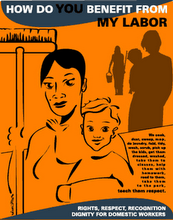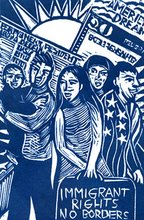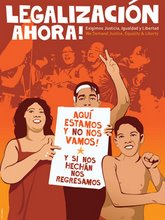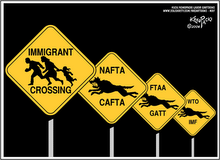June 06, 2007
Margot Pepper
Recently, sending a message of resistance to U.S. Immigration and Customs Enforcement (ICE), Berkeley and Oakland, California adopted sanctuary city measures disallowing the use of city funds and staff time in aiding Immigration and Customs Enforcement (ICE). Over 60 sanctuary city initiatives protecting immigrants have been promulgated in 21 states across the United States. Critics of immigration reform argue that sanctuary proposals send the wrong message to immigrants who, they argue, are responsible for eroding citizens' living standards. They claim stiffer penalties and stronger barriers are the answer. Little publicized is the fact that actually the opposite is true. Rather than posing a monumental problem, undocumented migration is a desired outcome of unequal international trade policies, boosting the living standards of U.S. citizens and enriching a powerful sector of the U.S. economy. Rather than discourage migration, dangerous but surmountable barriers and unenforceable, cruel laws only contribute to the "illegal," status of needed workers, rendering them a cheap, profitable source of labor.
A Public Policy Institute of California report (2/27/07) by University of California, Davis, economist Giovanni Peri demonstrates that "During 1990-2004, immigration induced a 4 percent real wage increase for the average native worker. An increase in the number of immigrants evidently increases the demand for tasks performed by native workers and raises their wages."
"Between 1990 and 2004, as the percentage of immigrants in California's labor force rose, immigration helped boost natives' wages as much as 7 percent, even giving a tiny bump to native high school dropouts," reports Kristin Bender in the Oakland Tribune, (2/28/07.)
But U.S. workers are not the biggest winners in the "immigrant sweeps-takes." The greatest beneficiaries of cheap immigrant labor, says Harvard economist George Borjas, are employers. It is widely-known that undocumented immigrants are less likely to hold union jobs and are willing to work for wages under the minimum wage, without benefits and at jobs citizens are unwilling to accept. During an immigration peak in the United States from the third quarter of 2001 to the present, the share of GDP going to corporate profits has soared from 7.0 percent to 11.6 percent, while the share going to labor compensation declined by 2.4 percentage points, according to economist Edwin S. Rubenstein.
One of the sources of the immigration surge was the implementation of the North American Free Trade Agreement (NAFTA) in the early 1990s. Thanks to protectionist measures like NAFTA, over an eight year period, "Resource transfers from the poor to the rich amounted to more than $400 billion," reported Massachussetts Institute of Technology professor Noam Chomsky in the Nation ("Notes on NAFTA.") "The World Bank reports that protectionist measures of the industrialized countries reduce national income in the South by about twice the amount of official aid to the region--aid that is itself largely export promotion," Chomsky states.
The losers in the game, of course are working Mexicans. In Mexico, "Poverty has risen by over 50% during the first four years of NAFTA and wages in the manufacturing sector have declined," reports the Data Center.
A 2004 report published by the U.S. House of Representatives Committee on Ways and Means states that "At least 1.5 million Mexican farmers lost their livelihoods to NAFTA." The situation is only expected to worsen in 2008 when Mexico is required to comply with a NAFTA deadline to totally eliminate its corn and bean import tariffs. A large sector of U.S. workers have also taken a big hit from NAFTA, as union jobs are farmed out overseas to non-union labor, widening the chasm between the rich and poor.
Many policy experts predicted that the Mexican farmers displaced by NAFTA would migrate to the United States. Indeed, a comparison of U.S. censuses of 1990 and 2000 shows "the number of Mexican-born residents in the United States increased by more than 80 percent," states Jeff Faux in "How NAFTA Failed Mexico," The American Prospect (July 3, 2003.) "Some half-million Mexicans come to the United States every year; roughly 60 percent of them are undocumented. The massive investments in both border guards and detection equipment have not diminished the migrant flow; they have just made it more dangerous. More than 1,600 Mexican migrants have died on the journey to the north."
While NAFTA is responsible for the latest "migration hump," it is not the sole culprit. Practices by bodies like the World Trade Organization, "along with the programs dictated by the International Monetary Fund and World Bank, have helped double the gap between rich and poor countries since 1960," reports Noam Chomsky in The Nation. The ensuing foreign debt deprives these countries from accumulating capital to develop competitive industries and has lead to mass migration northward. This trend has been in operation for hundreds of years, as traditionally, there has been a migration trend originating in colonized countries toward the source of the economic disparities.
Given the fact that the presence of undocumented workers enriches the corporate sector, particularly in developed countries, it is not unreasonable to conclude that a powerful sector of the U.S. economy would be severely harmed should undocumented workers gain resident status. In other words, part of the success of programs like NAFTA is the byproduct of cheap, undocumented labor, both native to Mexico and migrant.
A little known, but related, fact is that draconian, unenforceable immigration policies, such as Operation Return to Sender, are actually products of NAFTA. After NAFTA was passed by Congress in 1992, "the agreement raised concerns in the U.S. about immigration from south of the border," according to "NAFTA, The Patriot Act and the New Immigration Backlash" by the American Anthropological Association. To counter the predicted influx of Latin Americans, President Bill Clinton signed The Illegal Immigration Reform and Immigrant Responsibility Act of 1996. "The 1996 Welfare Reform bill included anti-immigrant and other measures that eliminated many social services for undocumented immigrants," the report states. The latest wave of ICE raids are a result of these long term policies.
The immigration reform bill under consideration in the Senate only strengthens the trend toward higher returns at the expense of migrant labor by cutting off family ties and creating an even lower tier than today's undocumented worker: the "guest worker" or bracero, whose legal status can be revoked by any whim of his employer. The bracero program was killed by labor organizers in 1964 spearheaded by Ernesto Galarza, with the blessings of Cesar Chavez. According to journalist David Bacon, "Chavez later said he could never have organized the United Farm Workers until growers could no longer hire braceros during strikes." Chavez and the UFW knew that stemming the flow of immigration required offering a living wage, not only to both documented and undocumented workers within the United States, but to workers abroad as well.
Recently, the deportation of 7-year old Gerardo Espinoza, a top student at Rosa Parks school in Berkeley, California whose only recourse to claim his right to education as a U.S. citizen was to remain behind as an orphan, reverberated in various newspapers and internet sites. The story struck a chord because the case demonstrated that the vast majority of model immigrants who comply with current immigration policy are destined for outcomes as tragic as the separation of the Greek lovers Orpheus and Uridice. ICE's latest Operation Return to Sender is nothing more than another incentive to go underground. According to the Contra Costa Times and the San Francisco Chronicle, thousands of people have been detained in the Bay Area since the beginning of Operation Return to Sender, a campaign that has resulted in over 18,000 arrests nationwide and the deportation of 800 immigrants in Northern California cities alone. Yet this has not deterred the courageous marches on May first by thousands of immigrants for the last couple of years. By standing their ground, these Americans have every intention of complying with the current administration's edict to "Return to Sender-" since the "Sender," or source of the "immigration problem" lies not abroad, but on U.S. soil.
###
Margot Pepper is a journalist and author whose work has been published internationally by the Utne Reader, the San Francisco Bay Guardian, City Lights, Monthly Review, Hampton Brown and others. Her memoir, Through the Wall: A Year in Havana, was a top nomination for the 2006 American Book Award.
http://www.zmag.org/content/showarticle.cfm?ItemID=13014
skip to main |
skip to sidebar

















Blog Archive
-
▼
2007
(540)
-
▼
June
(37)
- Lost in migration
- Watchdog needs teeth
- Le profilage ethnique sévirait aux frontières
- Deconstructing "Return to Sender"
- Saul's Letter to President Bush
- Power from Below
- L.A. Story
- Doubt builds over deportation
- Implement Moratorium on Deportations
- New Canadians to drive demand for housing
- Lack of data on illegal workers skews U.S. economi...
- U.S. Senate pulls plug on immigration bill
- Deportation revoked for woman, daughter
- Immigration: la réforme échoue au Sénat américain
- Woman facing deportation gets to stay here
- Le Canada refuse un visa à deux humanitaires afric...
- Menacée d’excision, Fanta reste au Canada
- Mêmes droits... en théorie
- La police au secours d'un saisonnier
- Les citoyens seront consultés
- US - Refugee Roulette: Disparities in Asylum Adjud...
- Deportation ruling deems Lebanon safe
- LAL: Interference to Deportation
- Couverture médiatique pour la régularisation de Mm...
- Une petite Canadienne menacée
- Mobilisation aux Communes contre l'expulsion d'une...
- Fanta, 2 ans, menacée de mutilation
- Girl could risk genital mutilation
- Photo Essay: Racisme, Islamophobie et Securite Nat...
- Video: No One Is Illegal Toronto
- Imams to give citizenship lessons
- Woman seeks refugee status to protect daughter fro...
- Khadr’s fate in limbo after terrorist charges dropped
- Immigration Raid Leaves Sense of Dread in Hispanic...
- Stalled Refugee Appeal Division Gets a Nudge
- Broken vows, festering ill will blamed for native ...
- Community Organizations Call on Canadian Governmen...
-
▼
June
(37)


Qui sommes nous:
Solidarité sans frontières est un réseau basé à Montréal qui lutte en faveur de la justice et de la dignité pour tou-te-s les sans-statut. Nous sommes un regroupement de migrant-e-s, d'immigrant-e-s, réfugié-e-s et leurs allié-e-s. Nous mobilisons pour toutes ceux et celles qui se battent contre la déportation, la détention et les certificats de sécurité.
About us:
Solidarity Across Borders is a Montreal-based network of migrants, immigrants, refugees, and allies engaged in the struggle for justice and dignity for migrants and refugees. We mobilize for all who are caught in the immigration regime and for all who fight against deportations, detentions, and security certificates.


Labels:
- War on Terrorism/Guerre contre le terrorisme (81)
- Fortress North America (64)
- Secret Trials/Proces Secret (58)
- Exploitation: Immigrant Workers/Travailleurs-EUSES immigrantEs (45)
- Migrant Resistance (37)
- Sanctuaire/Sanctuary (35)
- Detention (31)
- "Reasonable" Accomodation (30)
- Deportation (29)
- Fortress Europe (26)
- Racism (22)
- Indigenous Resistance (15)
- Propaganda (14)
- Police Harrasment/Harcelement policiere (10)
- Racial Profiling/Profilage Racial (10)
- Guantanamo (6)
- Anti-racism/Contre le racisme (4)
- Palestian Refugees/RéfugiéEs PalestinienNEs (4)
- Solidarity Across Borders (4)
- Solidarité sans frontières (4)
- Don't Ask Don't Tell (3)
- unionization/syndicalisation (3)
- Guantanamo North (2)
- LGBTQ (2)
- Labour (2)
- People's Commission (2)
- Police State/Etat policier (2)
- White Supremacy (2)
- Women (2)
- Raids (1)


Info:
(514) 848-7583
sansfrontieres[at]resist.ca
www.solidarityacrossborders.org

Contributors


Links:




